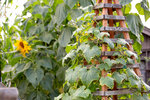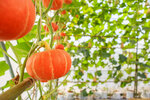

No two springs are exactly alike. And each spring, every gardener is one year older, so we’re never exactly alike either.
The more years of gardening behind us, the bigger the blessing. We’ve learned more every year, often without even being aware of it. This is true whether we’ve been in the garden for one year or 50. But it doesn’t take many years to learn the basics about what works, what doesn’t, and what is really too much trouble. And even last year’s first-timers who planted a few pots of flowers or a single zucchini plant will show up this spring with a little more confidence. We all bring our slightly improved selves outside every spring. We change as inevitably as the seasons.
While we were cozied up in our houses this winter, our gardens were changing too. New seeds, carried in on a breeze or pooped out by birds, have landed in our gardens and put down roots. Perennials like columbine have popped up in new places. Morning glory roots are snaking along underground, poised to leap out of the ground and strangle our flowerbeds starting about the first of April. And we can only imagine what all the slugs, bugs and worms have been up to while we were under our covers.
We can see, feel and smell that the time is coming soon to start anew. and that means trying new plants and new ways of growing them.
Here are some garden trends worth experimenting with. Some are suggestions from JOLT readers who are ahead of the pack:
Many gardeners have been growing cucumbers on trellises for years. This is the year I’m finally going to try it. I’m also going to dig out a climbing Cecile Bruner rose that grows so maniacally that it needs a much larger home. That will make room on the trellis for climbing squash.
Unless the weather improves next week, these concerns may seem premature. But these ideas need time to percolate in the brains of gardeners and aspiring gardeners. It’s the planning – not the immediate action – that’s timely now. We need to imagine our gardens in the full glory of midsummer in order to create one worthy of the full glory of midsummer.
Here’s a relevant anecdote: The morning after our big, wet, fast-melting snow, my front yard had a scattering of bright green grass blades rising above the white blanket. I realized – or maybe just imagined – that the sinking snow was outmatched by the rising grass, pushing up to receive every bit of light on every lengthening day.
Spring is coming.
Jill Severn writes from her home in Olympia, where she grows vegetables, flowers, and a small flock of chickens. She loves conversation among gardeners. Start one by emailing her at jill@theJOLTnews.com
2 comments on this item Please log in to comment by clicking here
GinnyAnn
I have a Cecile Brunner rose that is just a small stalk. I'm hoping it will soon grow into a marvelous bush with lovely blooms. I haven't killed it yet, so I'm optimistic. Your column is encouraging.
Saturday, February 24 Report this
wildnature
I grew lemon grass one year and it took off as an invasive, all over the place. So I got rid of it. Even though I love the smell of it. Or maybe it was lemon balm? What is the one they make a lovely perfume out of?
Sunday, February 25 Report this